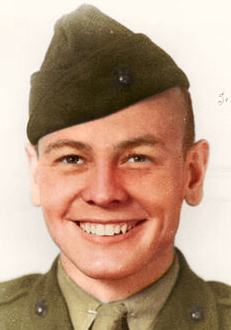CPL Edward Andrew Bennett Jr., 24, USA (1920-1983)
Company B, 1st Battalion, 358th Infantry Regiment, 90th Infantry Division
Heckhuscheid, Germany
February 1, 1945
Presented October 12, 1945
The President of the United States of America, in the name of Congress, takes pleasure in presenting the Medal of Honor to Corporal Edward Andrew Bennett, United States Army, for conspicuous gallantry and intrepidity in action above and beyond the call of duty on 1 February 1945, while serving with Company B, 1st Battalion, 358th Infantry Regiment, 90th Infantry Division, in action at Heckhuscheid, Germany.
Corporal Bennett was advancing with Company B across open ground to assault Heckhuscheid, Germany, just after dark when vicious enemy machinegun fire from a house on the outskirts of the town pinned down the group and caused several casualties. He began crawling to the edge of the field in an effort to flank the house, persisting in this maneuver even when the hostile machine gunners located him by the light of burning buildings and attempted to cut him down as he made for the protection of some trees. Reaching safety, he stealthily made his way by a circuitous route to the rear of the building occupied by the German gunners. With his trench knife he killed a sentry on guard there and then charged into the darkened house. In a furious hand-to-hand struggle he stormed about a single room which harbored seven Germans. Three he killed with rifle fire, another he clubbed to death with the butt of his gun, and the three others he dispatched with his .45 caliber pistol. The fearless initiative, stalwart combat ability, and outstanding gallantry of Corporal Bennett eliminated the enemy fire which was decimating his company’s ranks and made it possible for the Americans to sweep all resistance from the town.
